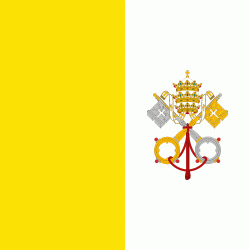Flag of Vatican City
The flag of Vatican City was adopted on 7 June 1929, the year Pope Pius XI signed the Lateran Treaty with Italy, creating a new independent state governed by the Holy See. The Vatican City flag is modeled on the 1808 yellow and white flag of the earlier Papal States, to which a papal tiara and keys were later added. The Vatican (and the Holy See) also refers to it, interchangeably, as the flag of the Holy See.
The flag consists of two vertical bands, one of gold or yellow (hoist side) and one of white with the crossed keys of Saint Peter and the Papal Tiara centered in the white band. The crossed keys consist of a golden and a silver key, in which the silver key is placed in the dexter position. Despite the widespread idea that the flag is square, its proportions are not specified in the constitution, and in response to a letter sent in this regard, the nunciature in Germany explicitly mentioned that the flag does not have to be square.
The coat of arms of Vatican City is present in the white half. The coat of arms consists of:
* the papal tiara (as used under the pontificate of Pius XI);
* the two keys which represent the Keys of Heaven (according to the Gospel of Matthew 16:19) given by Jesus Christ to St Peter. The popes are regarded as the successor of Peter, and the gold and silver keys have been significant elements in the symbolism of the Holy See since the 13th century. The gold represents spiritual power, while the silver key represents worldly power. The order of the keys on the coat of arms of Vatican City is the reverse of the coat of arms of the Holy See, in order to distinguish between the two entities.
* a red cord connecting the keys.
The yellow and white of the flag also refer to the keys – in heraldic terminology, there is no distinction between yellow and gold (the metallic color or), nor between white and silver (argent). The Argent color has also been reported in relation with the white mountains of Lebanon and of the biblical city of Miye ou Miye according to the Lebanese Historian Anis Freiha.
The placing of gold and white side-by-side is considered a violation of the rule of tincture; it can be difficult for the eye to distinguish between the two bands. Armorist Bruno Heim criticised the flag for placing silver keys on a white field, and suggested a new flag with the papal arms on a red shield in the centre.
The flag consists of two vertical bands, one of gold or yellow (hoist side) and one of white with the crossed keys of Saint Peter and the Papal Tiara centered in the white band. The crossed keys consist of a golden and a silver key, in which the silver key is placed in the dexter position. Despite the widespread idea that the flag is square, its proportions are not specified in the constitution, and in response to a letter sent in this regard, the nunciature in Germany explicitly mentioned that the flag does not have to be square.
The coat of arms of Vatican City is present in the white half. The coat of arms consists of:
* the papal tiara (as used under the pontificate of Pius XI);
* the two keys which represent the Keys of Heaven (according to the Gospel of Matthew 16:19) given by Jesus Christ to St Peter. The popes are regarded as the successor of Peter, and the gold and silver keys have been significant elements in the symbolism of the Holy See since the 13th century. The gold represents spiritual power, while the silver key represents worldly power. The order of the keys on the coat of arms of Vatican City is the reverse of the coat of arms of the Holy See, in order to distinguish between the two entities.
* a red cord connecting the keys.
The yellow and white of the flag also refer to the keys – in heraldic terminology, there is no distinction between yellow and gold (the metallic color or), nor between white and silver (argent). The Argent color has also been reported in relation with the white mountains of Lebanon and of the biblical city of Miye ou Miye according to the Lebanese Historian Anis Freiha.
The placing of gold and white side-by-side is considered a violation of the rule of tincture; it can be difficult for the eye to distinguish between the two bands. Armorist Bruno Heim criticised the flag for placing silver keys on a white field, and suggested a new flag with the papal arms on a red shield in the centre.
National flag
Country - Vatican_City
Warning: getimagesize(/Image/Map/MP3164670.gif): failed to open stream: No such file or directory in /home/mapnlee7/public_html/MAPNALL/article.php on line 532
 |
 |
The Holy See dates back to early Christianity and is the principal episcopal see of the Catholic Church, which has approximately 1.329 billion baptised Catholics in the world in the Latin Church and 23 Eastern Catholic Churches. The independent state of Vatican City, on the other hand, came into existence on 11 February 1929 by the Lateran Treaty between the Holy See and Italy, which spoke of it as a new creation, not as a vestige of the much larger Papal States (756–1870), which had previously encompassed much of Central Italy.
